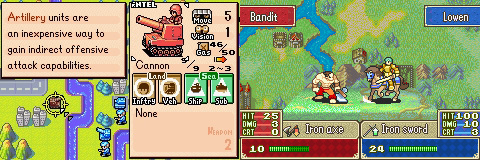Game Boy Memories Part #3
May 7th, 2009

Game Boy Advance
It’s getting harder to discuss the Game Boy the further I move along the line of iterations. The quality of games per each platform is increasing, and generally speaking so has my enjoyment with each, yet the nostalgia factor is shrinking too.
My brother had earned enough money through cash-in-hand jobs that he was able to buy a himself a Game Boy Advance within a year of its release. Fortunately for me, I was able to crib off his hard work for a couple of years until the Game Boy Advance SP was released. I originally wanted so desperately to own one of the limited edition, ultra-slick Rip Curl GBA SP units (pictured in the header). Typically I lucked out and most copies were snapped up quickly while I tried to scrounge together another $20 to make up the price tag.
Golden Sun was the first title my twin bought, recommended positive press on the magazine scene. I remember the first time I played it, sitting in my room, in the same spot I am now, with headphones on, juggling the unit to gleam enough of the sun’s rays. The music was incredible, it had a real airy atmosphere to it. I remember pausing for 20 minutes at the end of the first dungeon to sample the musical score. The graphics too had a pseudo-3D look to it thanks to shaded sprites (giving each body part a circular appearance), shadows and other tricks the game employed to create a sense of depth. The battles were dynamic, fast and engaging, a technical powerhouse of ideas and a clear leap above the SNES. Golden Sun was an early look at the future potential of the GBA. It’s a pity there weren’t more titles to peak Golden Sun‘s aptitude to sharp presentation and design – very contemporary for its time.

I sometimes feel trapped in a sad world where Advance Wars fans outnumber Fire Emblem fans. We’re all marching to spanky tunes, sharp transitions and a youthful air. The charisma is undeniable upbeat, perhaps too much so for a game that tackles the topic matter of war. I love Advance Wars for all it offered; mainly busting S ranks off the easy maps in the War Room while failing to worm my way through the main story. Advance Wars had this unshakable layer of intellect to it, the same variation of intellect that makes one a good player of chess – I usually stuck to draughts. There’s just a mentation that I always buggered up when strategizing my units, a way of thinking that is still out of my mind’s reach that make me at odds with this series.
Fire Emblem picked up those pieces, and welcomed me to the opposite end of the SRPG genre from much beloved Final Fantasy Tactics (PSone). This is strategy that speaks to me, well contextualized (steeped in hierarchic Medieval tongue) and better animated. The battle animations still leave me awe inspired, the fluidity of the sprite work encouraged me to to make my own animated gifs from sprite dumps of the game. I’m sure if I were to one day conduct a proper analysis of Fire Emblem it would reveal some embarrassing similarities with the Advance Wars framework. Enough so that I’d realize my fear of Advance Wars is all just in my head. Either way, this title strengthened my love for all things SRPG and instantly turned me into an conscious consumer of Intelligent Systems’ games. Seriously, this developer has breathed much variation into the Nintendo fold.

Metroid Fusion and Metroid Zero Mission are another pair of unforgettable GBA classics – seem to be operating it twos today. Purists may balk at the linearity of Metroid Fusion, but the title brought some interesting elements to the franchise, most notable of which being SA-X, the evil Samus. Her presence was unnerving, marked with cold foot steps through the abandoned halls. Haters of Fusion say that Zero Mission is a better game, and they’re probably right. Fusion had a stylish, light-blue elegance to it, the environments felt lived in, a naturally conjoining network of catacombs overrun by vegetation and abandonment – it was a modern Metroid. Zero Mission feels bulky and recycled (as it is) in comparison; cliched and dated. Although some areas of the used map are fleshed out, the core framework is centred around 3-4 core divisions as in the original (this is a remake by the way). The game places you in limbo, balancing sending you back an forth to several divisions of the map. The game only truly comes into its own when Samus attempts to leave Zebes and crash lands back on the planet near the Space Pirate Mothership. Her abilities and power suit are striped and we get to play in an extended episode, where she stealthily infiltrates the alien compound. Playing as the tight skinned “Zero Suit Samus”, the game becomes conscious of the fandom in ways Nintendo normally don’t permit. Nice call.
And then we arrive at Final Fantasy Tactics Advance; the most atrocious abomination ever to be accepted by the video gaming community. No, no, no, that’s enough! I refuse to attach myself to this sin. Post over.



 Game Design Companion: A Critical Analysis of Wario Land 4 - $7.99
Game Design Companion: A Critical Analysis of Wario Land 4 - $7.99 Level Design: Processes and Experiences
Level Design: Processes and Experiences Speed Boost: The Hidden Secrets Behind Arcade Racing Design - $5.99
Speed Boost: The Hidden Secrets Behind Arcade Racing Design - $5.99 Adventures in Games Analysis: Volume I - $5.99
Adventures in Games Analysis: Volume I - $5.99







